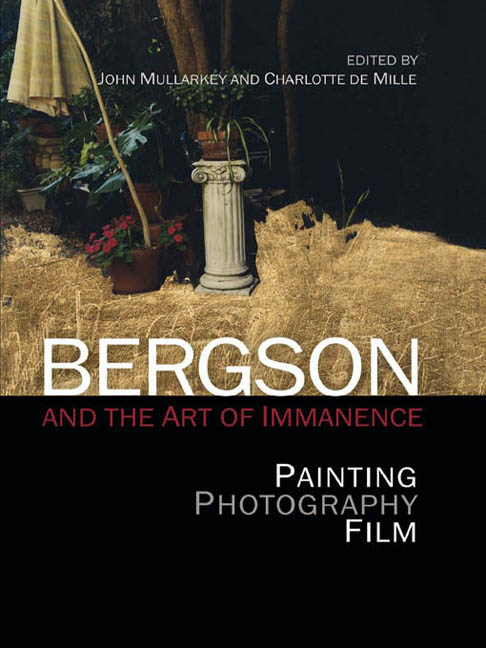Book contents
- Frontmatter
- Contents
- List of Illustrations
- Notes on Contributors
- Introduction: Art's Philosophy – Bergson and Immanence
- Part I Bergson, Art, History
- 1 Bergson, History and Ontology
- 2 Art History, Immanently
- 3 Art History, Less Its Conditions of Possibility: Following Bergson's ‘Le Possible et le réel’
- 4 Matisse, Bergson, Oiticica, etc.
- 5 Bergson Before Deleuze: How to Read Informel Painting
- 6 Revolutionary Immanence: Bergson Among the Anarchists
- Part II Unconditional Practice
- Part III Immanence of the Visible
- Afterword: An Art Historical Return to Bergson
- Index
5 - Bergson Before Deleuze: How to Read Informel Painting
from Part I - Bergson, Art, History
Published online by Cambridge University Press: 07 December 2017
- Frontmatter
- Contents
- List of Illustrations
- Notes on Contributors
- Introduction: Art's Philosophy – Bergson and Immanence
- Part I Bergson, Art, History
- 1 Bergson, History and Ontology
- 2 Art History, Immanently
- 3 Art History, Less Its Conditions of Possibility: Following Bergson's ‘Le Possible et le réel’
- 4 Matisse, Bergson, Oiticica, etc.
- 5 Bergson Before Deleuze: How to Read Informel Painting
- 6 Revolutionary Immanence: Bergson Among the Anarchists
- Part II Unconditional Practice
- Part III Immanence of the Visible
- Afterword: An Art Historical Return to Bergson
- Index
Summary
Gilles Deleuze ‘rediscovered’ Bergson, according to some of the ‘New Bergsonists’. Yet, far from there being a lapse in terms of Bergson's impact, he was named ‘philosopher of the age’ by the Nouvelle Revue Française in 1939, and maintained a vital presence in France in the 1940s, not only in philosophical and Catholic circles. His thought was key to the understanding of the turn in painting known as the informel and the related movement known as lyrical abstraction. Created in Occupied France at the moment of Bergson's death, a multifarious body of work, initially full of spirituality and anguish, expressed a new attitude to painterly matter, time, space and duration. It was based upon the encounter of matter and memory: Bergson's Matière et mémoire (1896) was referred to explicitly, and continued to be quoted as a gloss on painting through to the 1960s.
The specifics of the informel, its production and its perception, including non-verbalised feelings and affects as well as explicit Bergsonian triggers, become lost in translation when seen as a European-wide small-scale riposte to the painting of Jackson Pollock and the American Abstract Expressionists. In the 1990s a new orthodoxy issuing from America saw a European informel generated from Georges Bataille's definition of the informe – a verbal and conceptual slippage – embodied in Rosalind Krauss's exhibition, L'nforme: Mode d'emploi (Formless, A User's Guide), of 1996. European art was instrumentalised, while the formal origins of an art whose lineage was entirely hostile to Surrealism were obfuscated. The impact of war, Occupation and the context of Bergson's death had no place in this story.
Henri Bergson died in 1941, aged eighty-one. Nobly, he had renounced all previous honours and awards bestowed upon him, rather than accept exemption from the anti-Semitic laws imposed by the Vichy government. As an expression of solidarity with so many friends, colleagues and respected intellectuals, he refused to engage with any public procedures of conversion, despite his increasing engagement with Catholicism.
- Type
- Chapter
- Information
- Bergson and the Art of ImmanencePainting, Photography, Film, Performance, pp. 80 - 93Publisher: Edinburgh University PressPrint publication year: 2013

